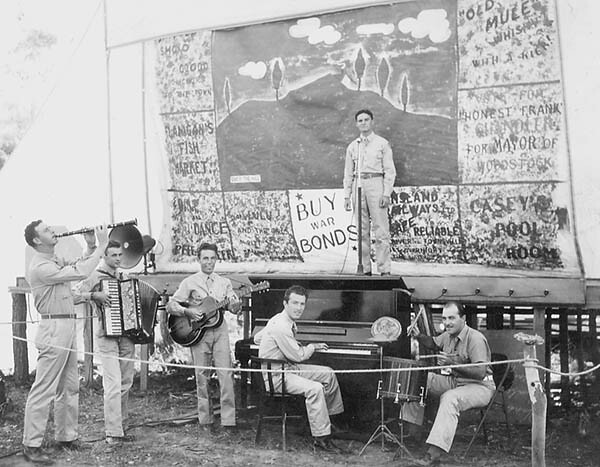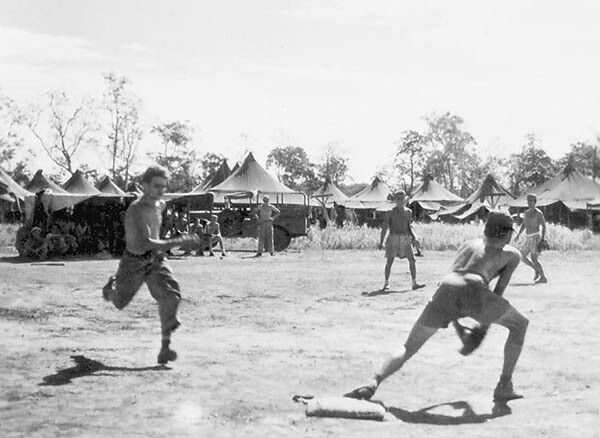After approximately nine months of combat missions, the 22nd Bomb Group’s B-26s had reached the age of being designated war-weary. Due to the “Europe First” mentality, those fighting in the Pacific Theater had been receiving far fewer replacement aircraft than they desperately needed. In the case of the 22nd, this was a breaking point for the Group. Headquarters did not feel that men could safely fly in their B-26s any longer and ordered the Group to stand down on January 11, 1943.
Not long after the orders were received, the 19th and 33rd Bomb Squadrons were told that they were moving from Iron Range back to their old camp at Woodstock. The 500+ mile trip was filled with torrential downpours, delays and crowded conditions aboard the S.S. Paine Wingate. Once the men made it back to Woodstock, though, they happily found that their camp had been improved since their last stay. This time, they enjoyed electricity in their tents, upgraded shower and latrines and eating in wooden mess halls. Picking weevils out of bread was also a distant memory, as the food had greatly improved.
As the men adapted to a slower life, they enjoyed the routine flight training and transport runs, playing sports, and visiting cities such as Sydney and Brisbane. They read books, put on skits, played music and a few of the men decided to run for mayor in the Australian town nearby. Their campaigns were unsuccessful.

One way to pass the time while under orders to stand down is to perform. A stage was built at Woodstock during the spring of 1943, and numerous shows, both locally produced and traveling USO groups, entertained the troops. Several talented enlisted men are shown here during one of these performances. On stage was Milt Weiner, singer and emcee. From left the others were Walter Shook on the clarinet, Jones on the accordion, Scott Day on the guitar, “Buckwheat” Westmoreland on the piano and Davis on the drums. (Walter Gaylor Collection)

What does a combat unit do while under orders to stand down? Various leisure time activities helped pass the time during the spring of 1943, with baseball being one of the most popular. Under the direction of the newly assigned Special Services Officer, 2/Lt. “Buck” Weaver, many teams were formed and tournaments were organized. This photo was taken at Reid River, the camp for the 2nd and 408th Bomb Squadrons. (William K. Miller Collection)
Days of little activity stretched into weeks and the men grew restless. They wanted to be back in the action, helping the Allies fight in New Guinea. The fate of the 22nd was still unknown, leading to various rumors going around the camp. Maybe they would go back to the U.S. for reassignment, they would be re-equipped with B-25s, or they would receive new B-26s. It wasn’t until mid-March when they finally got some answers.
General George C. Kenney and a few others had flown to Washington DC, where they met with the Joint Chiefs of Staff about operation plans for the remainder of the year. Out of the meeting came an authorization for additional aircraft, an order to push the Japanese out of New Guinea as far as Madang and a policy to rotate original crews back to the States. The 22nd Bomb Group was also going to transition from a medium bombardment group to a heavy bombardment group equipped with B-24s.
Before the transition to the B-24, three of the four squadrons would fly B-25s for a short time (the fourth, the 19th, would stick with the B-26 a little longer). Like the B-17, the B-26 would be phased out of operation in the Pacific Theater and sent to Europe. This news was not entirely welcomed by the crews who had grown fond of their fast, durable B-26s and they weren’t certain how the B-25 would hold up in comparison. Nonetheless, the days of inactivity soon reached an end as the 22nd received new crews, said goodbye to the old crews being sent Stateside and refurbished as many B-26s as they could for the 19th Bomb Squadron’s new “Silver Fleet.”
In July, the Silver Fleet of unpainted B-26s left the rest of the 22nd in Australia and flew to Dobodura, where the crews would began flying combat missions on July 21st. The three remaining squadrons began receiving their new B-25s in Australia and wasted no time learning the ins and outs of the new planes. Transition training took approximately three months. Finally, the 2nd, 408th and 33rd Squadrons were sent back to combat in early October. All four squadrons were reunited in combat on October 14th.
Read more about the 22nd Bomb Group in Revenge of the Red Raiders.

An American mayor of an Australian town? What a pity he didn’t win. Over here, the Cambridge Evening News used to carry all the baseball scores.
LikeLike
Funny! Have to wonder what would have happened had an American won. Does the paper you mentioned not report baseball scores anymore?
LikeLike
Great report on their off-time. I had a friend send some pictures of how important sports was to the men. I figure one day I’ll make a post out of them. I still can’t compete with you expertise though.
LikeLiked by 1 person
Thanks. You’ll write a great sports post. Bet there’s a lot of information about that subject. Our expertise comes from years of research on very specific topics.
LikeLiked by 1 person
People tend to only look at the combat. They forget the huge army of different jobs that it takes to keep soldiers on the front and to maintain their morale, fitness and well-being.
LikeLiked by 2 people
No idea how accurate, but I was told that it takes 200 guys at the back to keep just one at the front. (Makes better sense if you share the same two hundred around a bit, perhaps?)
LikeLiked by 1 person
I’m always telling people that it takes an Army to keep one soldier at the front! It’s a huge chain of jobs that encompass the military – so everyone has to pull their weight.
LikeLiked by 1 person
Any down-time spent with your comrades must have been vital for the crew’s. Although I am trying to ignore the baseball at the moment. The Twins have had a terrible start to their season!
LikeLike
Pingback: International Historical Research Associates | Baseball at Reid River
Reblogged this on Pacific Paratrooper and commented:
Keeping the troops focused and in shape while not in combat….
LikeLike
Fascinating blog post. As a former Army Morale, Recreation, and Welfare (MWR) type, many of those off duty pastimes are still being offered by the Army. Some of the Army MWR specialists used to be jealous of the USO and looked upon it as the ‘competition’ that did not have to abide by some of the same rules handcuffing what the Army allowed. I found the USO a wonderful organization to partner with.
LikeLike
I found this fascinating. I never knew they could have so much down time. I enjoyed reading how they kept busy to pass the time.
LikeLike
Excellent insight into the leisure activities of the American crews in Australia, their presence left a lasting impression on Australia, pity the American nominee for Mayor wasn’t elected, who knows he may have gone on to be Prime Minister of Australia, and we would have become another State of America.
LikeLike